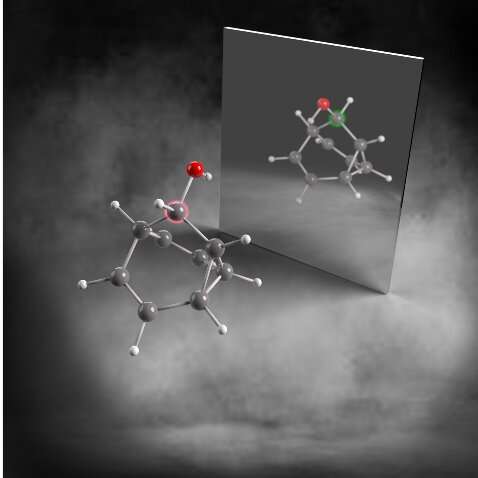This article has been reviewed according to Science X's editorial process and policies. Editors have highlighted the following attributes while ensuring the content's credibility:
fact-checked
peer-reviewed publication
trusted source
proofread
Scientists develop new concepts about the shape and dynamic nature of molecules

Scientists have demonstrated in a new study that carbon-based molecules can be much more dynamic than previously thought.
When a carbon atom forms four bonds to different groups, the molecule can exist in two mirror image forms. These mirror image forms are vital in medicine because they have different biological activities.
Usually, it is impossible to interconvert between these "enantiomers" because to do so would require a bond to be broken, a process that needs too much energy.
The researchers from Durham University and the University of York demonstrated that if the chiral center was part of a dynamic molecular cage structure, then a simple rearrangement of the cage could lead to inversion of the mirror image form of the molecule.
In this way, carbon-based stereochemistry, which is normally considered to be fixed and rigid, can become dynamic, fluxional and responsive—a new paradigm in carbon-centered chirality.
The findings are published in the journal Nature Chemistry.
The molecular cage has nine carbons atoms in its structure, which are held together by a pair of carbon–carbon double bonds and a three-membered cyclopropane ring. This combination of bonds allows some of the bonds in the structure to trade places with one another spontaneously.
Project lead investigator, Dr. Aisha Bismillah of Durham University, said, "Our dynamic carbon cages change their shape extremely quickly. They hop back and forth between their mirror image structures millions of times a second. Seeing them adapt to match changes in their environment is truly remarkable."
Further uncovering this unique dynamic form of stereochemical interconversion, the researchers demonstrated that the preferences of the cage could be transmitted to nearby metal centers, opening the possibility that this type of responsive chirality might find uses in catalysis, and the synthesis of chiral molecules for biomedical applications.
Reflecting on the way in which these results overturn established ideas, Dr. Paul McGonigal of University of York, said, "The way our dynamic carbon cage interacts with other molecules and ions is fascinating. The cage adapts, giving the mirror-image structure with the 'best fit."
"We hope, in due course that this intriguing bonding concept will be found to apply in other contexts, and potentially used to underpin new applications for more dynamic molecular materials."
More information: Paul McGonigal, Control of dynamic sp3-C stereochemistry, Nature Chemistry (2023). DOI: 10.1038/s41557-023-01156-7. www.nature.com/articles/s41557-023-01156-7
Journal information: Nature Chemistry
Provided by Durham University





















